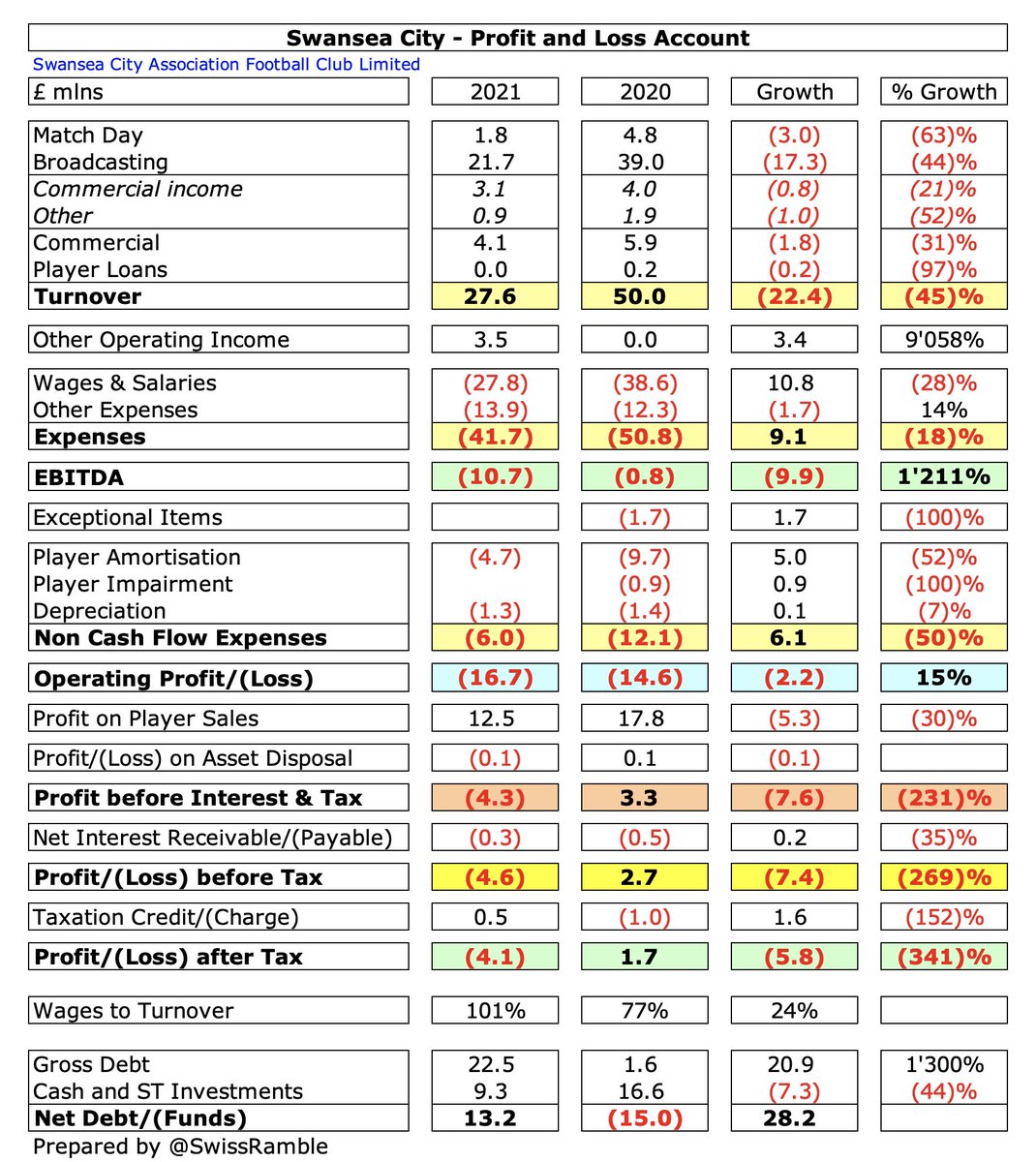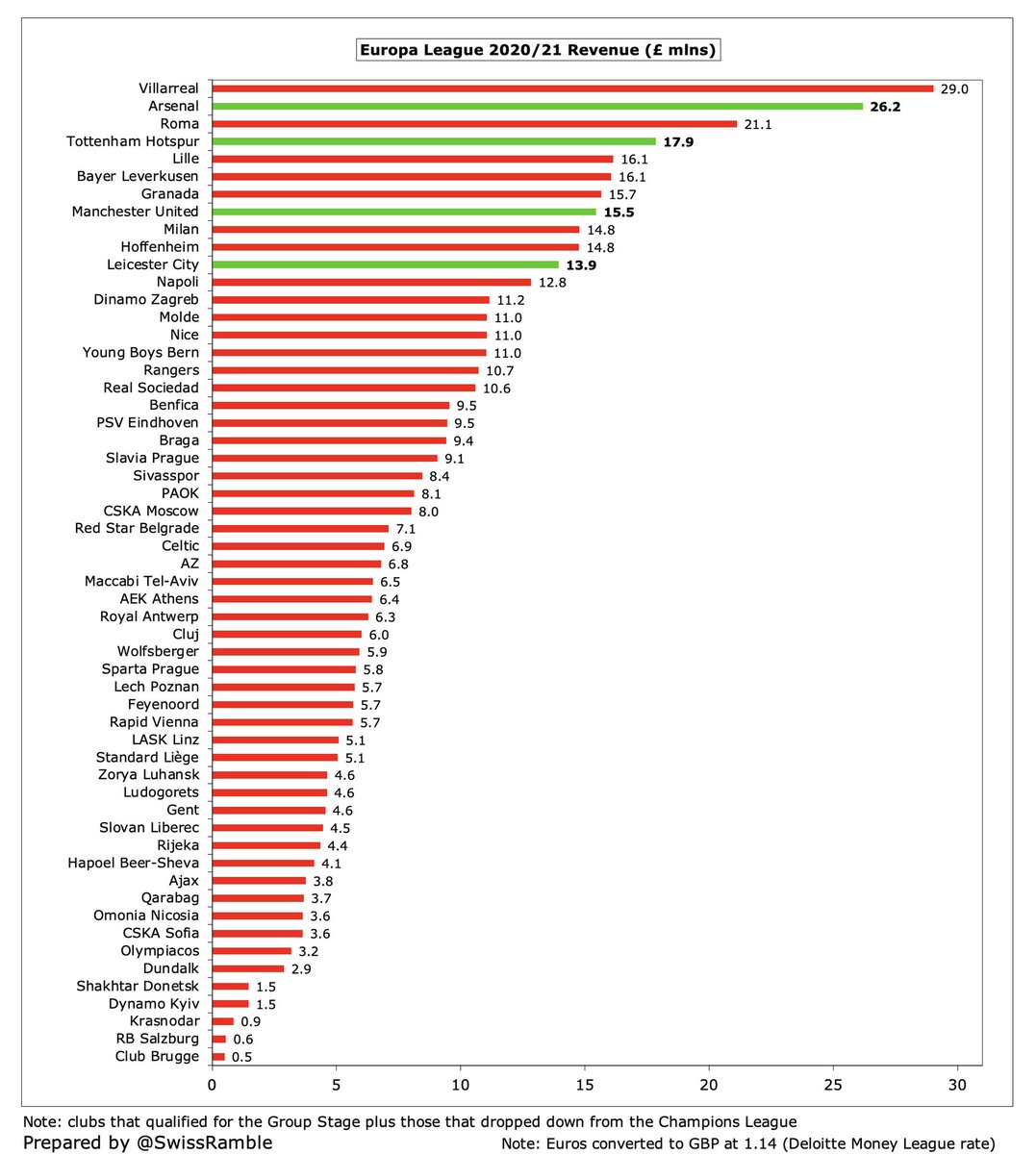
Birmingham City’s 2020/21 financial results covered a season when they finished 18th in the Championship, a slight improvement on previous season’s 20th place. Head coach Aitor Karanka was replaced by Lee Bowyer in March 2021. Some thoughts in the following thread #BCFC
#BCFC loss narrowed from £18.2m to £4.8m, largely due to profit on player sales rising £15m to £27m, thanks to Jude Bellingham’s move to Borussia Dortmund. Revenue dropped £9.1m (40%) from £22.8m to £13.7m, due to COVID, partly offset by expenses falling £7m (14%). 

COVID drove reductions in match receipts, down to zero from £4.7m, and commercial, which more than halved from £9.3m to £4.4m. In contrast, broadcasting rose £0.5m (5%) to £9.3m, while other operating income increased £0.3m to £1.8m, including £659k COVID grant. 

To offset the steep revenue reduction, #BCFC cut the wage bill, but only by 5% from £33.1m to £31.6m, and player amortisation by £1.2m (15%) from £8.4m to £7.2m. Other expenses fell £4.6m (44%) to £5.9m, mainly due to the lower cost of staging home games.
Although a loss is rarely good news, #BCFC £4.8m deficit was mid-table in the 2020/21 Championship with no fewer than 5 clubs posting losses above £20m, led by Bristol City £38m and Reading £36m. Two highest profits at clubs relegated from PL the previous season (#NCFC & #AFCB). 

#BCFC did not quantify the adverse impact of COVID-19, though this obviously impacted gate receipts, retail and hospitality revenue, even though these will be partly mitigated by a successful insurance claim with £2.5m paid after these accounts closed.
#BCFC bottom line was boosted by profit on player sales increasing from £11.5m to £26.5m, largely from the transfer of Jude Bellingham to Borussia Dortmund. That was pretty good, but still less than half the three relegated clubs: #NCFC, #AFCB and Watford (£56m to £60m). 

#BCFC have consistently lost money, only reporting a profit once in the last nine years – and that was just £1m in 2015. Since then, the club has accumulated £90m of losses – or £107m if the profit from the stadium sale in 2019 is excluded. 

#BCFC 2018/19 accounts included £17m profit from the sale of St Andrew’s (£23m proceeds less £6m book value), using some fancy financial footwork to try to meet FFP targets. Other clubs did the same thing, some even more egregiously, e.g. #DCFC sold their stadium for £81m. 

#BCFC have become increasingly reliant on player sales with £38m profit in the last two years (mainly Bellingham in 2021 and Che Adams to Southampton in 2020). However, this season’s gains will be significantly lower, as most departures were on a free transfer 

Excluding player sales, #BCFC underlying profitability is poor, as shown by their £30m operating loss in 2021. This metric has been consistently negative, though in fairness every club in the Championship posts substantial operating losses with ten of them above £30m. 



#BCFC revenue has fallen by £9.6m (41%) in the last two years from the pre-pandemic level of £23.3m to £13.7m. This is about a third of the £39m generated in 2012, the first season after relegation from the Premier League, which included a £15m parachute payment. 



Following the decrease, #BCFC £13.7m revenue is firmly in the bottom half of the Championship, only around a quarter of those clubs in receipt of the largest parachute payments, but also below clubs like NFFC £18m and Bristol City £17m. 

Championship revenue is hugely influenced by Premier League parachute payments, which are so significant that they make it difficult for clubs like #BCFC to compete, e.g. in 2019/20 a relegated club received £42m in year one, £34m in year two and £15m in year three. 

#BCFC broadcasting income rose £0.5m (5%) from £8.8m to £9.3m, partly due to iFollow streaming, though this was significantly lower than £45m they earned in the top flight in 2011. Most Championship clubs earn £8-10m TV money, but there is a huge gap to clubs with parachutes. 



#BCFC commercial income more than halved from £9.3m to £4.4m, as COVID meant the club could not make money from non-matchday stadium use. Unclear whether the figures included any Trillion Trophy naming rights. Still 10th highest in the Championship, but far below Stoke £12m. 



#BCFC have extended their shirt sponsorship with Irish bookmakers Boyle Sports by two years until 2023. Adidas replaced Nike as kit supplier in a four-year deal from the 2020/21 season.
#BCFC match day income dropped £4.7m to zero, as all home games were played behind closed doors. This revenue stream was only 16th highest in the Championship before the pandemic in 2019 with £5.2m, but that was well down from the £9.3m peak in 2012. 





After rising 5 years in a row, #BCFC average attendance (for games played with fans) dropped 9% from 22,483 to 20,412 in 2019/20, but this was still in the top ten in the Championship. 



#BCFC had £1.8m other operating income in 2020/21, including £659k COVID grant income. Accounts note that their £2.5m insurance claim relating to the pandemic was successful, so this will be included in 2021/22 accounts. Other clubs could already book such money last season. 



#BCFC wage bill fell 5% from £33m to £32m, as playing staff cut from 99 to 89. Down from £39m peak in 2018, but more than twice as much as £15m five years ago. Chairman Wenqing Zhao spoke of the “necessity to be responsible with our spending”, so more high earners will leave. 

Following the decrease, #BCFC £32m wage bill is 11th highest in the Championship, so they have badly under-performed. Around half the likes of Watford £68m, #NCFC £67m and #AFCB £57m (though the first two included hefty promotion bonuses). 

#BCFC wages to turnover ratio increased from 145% to 230%, badly impacted by COVID revenue reductions. In fairness, the vast majority of clubs in the Championship have unsustainable ratios well above 100% (with six over 200%), but the Blues are third highest (worst). 



Based on figures in the subsidiary, Birmingham City Football Club PLC, total directors remuneration rose by 34% from £561k to £749k, the 4th highest in the Championship, so seemingly not performance-related. Amount received by highest paid director was up 29% from £284k to £366k. 



#BCFC other expenses decreased by £4.5m (44%) from £10.4m to £5.9m, mainly due to lower costs for staging games without fans. Includes £1.25m annual rent paid to Birmingham City Stadium Ltd for the use of St Andrew’s (12-year lease to 2031). 

#BCFC player amortisation, the annual charge to write-off transfer fees over a player’s contract, fell £1.2m (15%) from £8.4m to £7.2m, around mid-table in the Championship, but a fair way below big spenders relegated from the Premier League, e.g. #AFCB £36m and Watford £33m. 



#BCFC spent £6.1m on player purchases, including Scott Hogan (Aston Villa), Sam Cosgrove (Aberdeen), Neil Etheridge (Cardiff City) and Jonathan Leko (WBA). This was 7th highest in the Championship, but a long way below the likes of Brentford, #NCFC and Watford (all £21 to 22m) 

#BCFC gross transfer spend increased to £51m in last 5 years, compared to only £6m in preceding 5-year period, despite EFL restricting purchases in 2018/19 following a breach of FFP regulations. Very little spent this season (only Bacuna), as many arrived on frees or via loans. 

#BCFC gross debt fell £5m from restated £128m to £123m. Amount owed to parent Birmingham Sports Holdings Limited down £43m from £116m to £73m, but £20m transferred to related party Oriental Rainbow Investments Ltd. Also £14m bank loan, £7m from EFL and £8m finance leases. 

This means that #BRFC debt has grown by a worrying £107m in just 5 years, so is now 6th highest in the Championship. Most of the debt is not an issue, as long as the owners continue to provide support, though it is interesting that some was replaced by external debt in 2020/21. 

The owner debt is interest-free, though repayable on demand, but #BCFC made a £2.3m interest payment in 2020/21, relating to leases and bank debt. This was actually the third highest interest payment in the Championship, only below Watford and Huddersfield Town. 

#BCFC cut transfer debt from £9m to £8m. This was still 5th highest in the Championship in 2020/21, but miles below the clubs recently relegated from the PL: Watford £62m, #AFCB £45m and #NCFC £23m. Owed £19m by other clubs, so Birmingham have £11m net receivables. 



After adjusting for non-cash movements, #BCFC had £35m negative cash flow, then made a £1m net interest payment, which was funded by £14m from player trading (sales £22m, purchases £8m) and £21m new loans. 





As a result, #BCFC cash balance fell slightly to £1.4m. This is on the low side, but most clubs in the Championship held less than £3m cash in the bank, emphasising the clubs’ reliance on their owners’ money. 

In fact, in the last 10 years #BCFC have required £128m loans (mainly from the owners) plus £20m from player sales to cover the club’s £133m operating losses, £4m interest and £4m capital expenditure. 

#BCFC owners’ lack of infrastructure investment is plain to see, as two stands of the ground have been closed since December 2020 due to safety concerns. The club has invested less than £4m in infrastructure in the last 10 years, which is one of the lowest in the Championship. 

Parent company BSHL has provided £111m funding in the last decade, most of which has come since 2017. That’s a lot of money, but significantly lower than some other clubs, e.g. QPR £283m, Stoke City £195m and Cardiff £194m, though this has clearly not been a guarantee of success. 



This support is essential, as the accounts state that #BCFC will need £40m additional funding from the owners up to January 2023, with the auditors once again noting a “material uncertainty” which casts “significant doubt” on the club’s ability to continue as a going concern.
#BCFC have already fallen foul of FFP rules, incurring a 9 points deduction in 2018/19 following overspend in 3-year monitoring period up to 2017/18. EFL also charged them with failing to comply with previously imposed business plan, but this only resulted in a reprimand.
It is worth noting that #BCFC FFP clock was “reset to zero”, so they were only back to a 3-year assessment in 2020/21. Club somewhat confusingly said it has “complied in all material aspects”, but my estimate suggests they were OK after allowable deductions and COVID impact. 

So #BCFC creative accounting (within the rules, to be clear) solved FFP for both 2018/19 and 2019/20, as their adjusted FFP losses were well within the limit. However, if the £17m stadium profit were excluded, their FFP losses would have been above the limit.
Although #BCFC chairman Wenqing Zhao has said that ultimate control of the club lies with the two majority owners, Paul Suen and Pech Vong, it’s difficult to understand the full picture. For more detail, the timeline of @almajir is always informative, not to mention eye-opening.
There have been numerous reports in the media recently about a possible takeover of #BCFC. Clearly, some things are happening in the background, but seasoned observers would urge caution until a deal is actually announced, as there have been many false dawns.
In the meantime, the owners have asked the fans to “trust the process”. Their stated objective is to “make #BCFC a success and return to the Premier League”, but that seems a tad optimistic, given the club has finished no higher than 17th in the Championship in the past 6 years.
• • •
Missing some Tweet in this thread? You can try to
force a refresh












